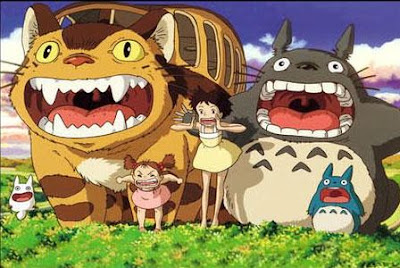noun
1. Japanese mythology. "Death god" or "death spirit", it is an entity in Japanese folklore that is responsible for making sure a person dies at the appropriate time and guiding their spirit to judgement in the afterlife.
EX. There is a theory that beloved character, Totoro from Studio Ghibli's My Neighbor Totoro (1988), is in fact not the cuddly character we think and the story is far more macabre than first impressions would have you believe; Totoro might be a shinigami, a god of death.
Apologies before we begin to anyone who might be offended by the notion, but I'll try to put my own spin on the notion that might make it more comfortable. Before we begin how about a delightful look at Southpark's delightful Totoro Cthulhu parody.
SOUTH PARK'S TOTORO-CTHULHU PARODY!
CTHULHU & CARTMAN THEME SONG!
When I first began writing this article, I though about using some horrific fan art of Totoro but decided that was unnecessary; mostly because of the fact that Totoro being a god of death doesn't necessarily making him a scary figure or turn the movie into a bad movie. Arguably, it just interprets the story in a compelling way. Let's start by looking at the beginning of the story...
In 1958, a professor and his two daughters move to the country to be closer to their ill mother recovering from a long-term illness at a nearby hospital. The theme of death begins here with the ill-mother and supernatural sightings begin appearing shortly after they arrive at the old house which is located near a giant tree (a spiritual symbol in Japanese folklore).
Their house is infested with seemingly harmless soot or dust sprites called "susuwatari". These creatures have a generally harmless effect in the movie but, in Japanese folklore, they represent a bad omen and those who can see them are said to be close to death or surrounded by death. In the film, the exorcise the spirits from the house by making them uncomfortable by filling the house with laughter (the sprites leave to seek out an an empty house their natural habitat). Irregardless, their appearance in such a mundane way could be a symbol of their closeness to their mother's sickness or could be something far more sinister.
My Neighrbor Totoro's story shares several elements with a controversial murder that occurred in real-life, the Sayama Incident, which occurred in 1963. The case goes that one day in Sayama (in Saitama prefecture) a young girl was kidnapped for ransom, raped, and murdered. Her older sister apparently founder her body and, traumatized by the event, when asked what she saw, she answered, "I met a larger Tanuki" or "I saw a giant cat monster". Later, the girl committed suicide.
Let's look at the first piece of evidence that makes an obvious connection; the kanji written on the box behind the old woman reads, "Sayamacha" or "Sayama tea". Setting the location quite firmly to the one of the crime.
The hospital from the film is supposedly based on a real-life location in Sayama.
The names of the little girl also link to May, the month crime was committed in two different ways; the youngest daughter's name is Mei (pronounced the same as "may") and the older sister's name, Satsuki, is a way to say May in Japanese.
I think there is some credence to the theory, but I am not completely sold on it just yet (Studio Ghibli has denied the theory multiple times). Yet, I do not find myself disturbed by the possibility of this being a story about the death of children because, for one thing, children do die. Furthermore, if Totoro is the guardian of dead children and guides them into the afterlife, then the afterlife doesn't seem so bad and Totoro is a still a good character. Death doesn't have to be evil; or rather the fantastic representations of them do not have to be. Totoro is there for the girls and is still a big sympathetic teddy bear. Regardless of the possibilities and the ramifications of knowing such a theory, I still love My Neighbor Totoro.









